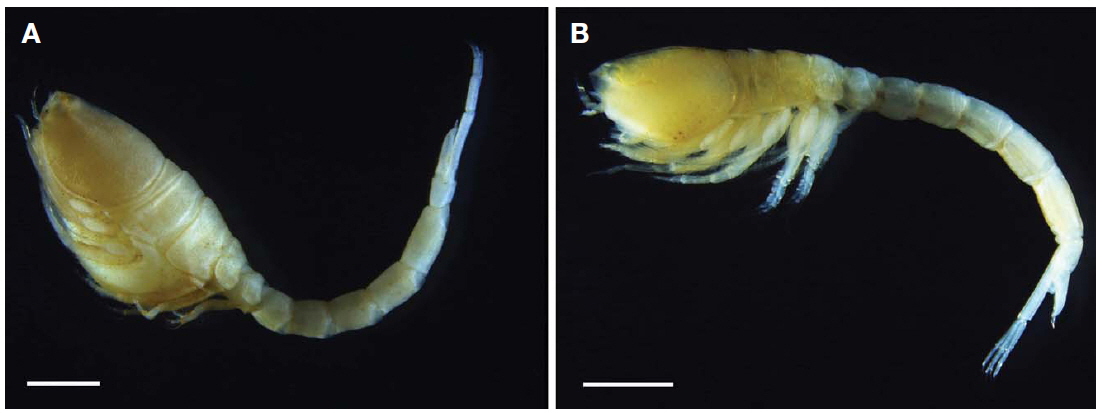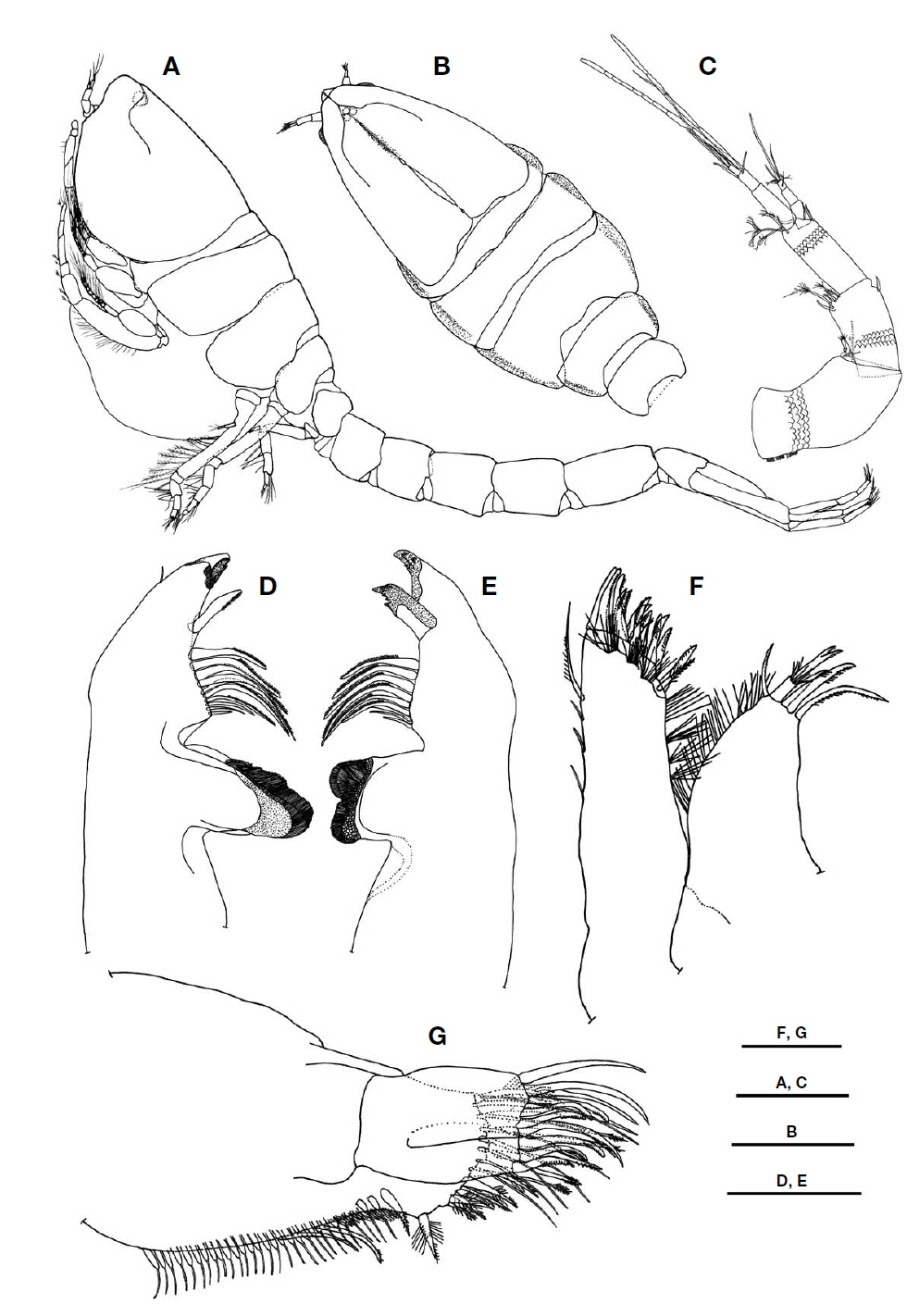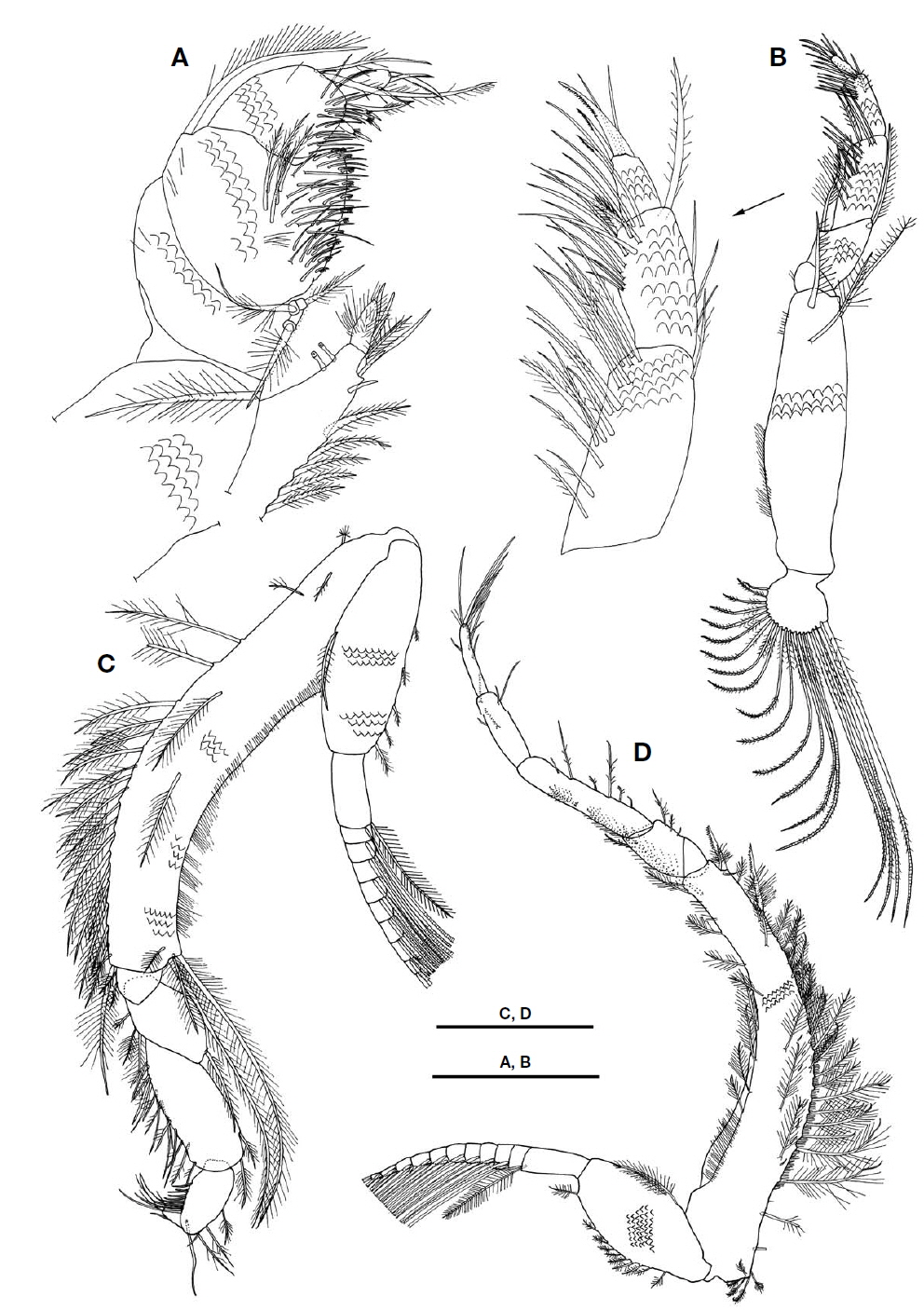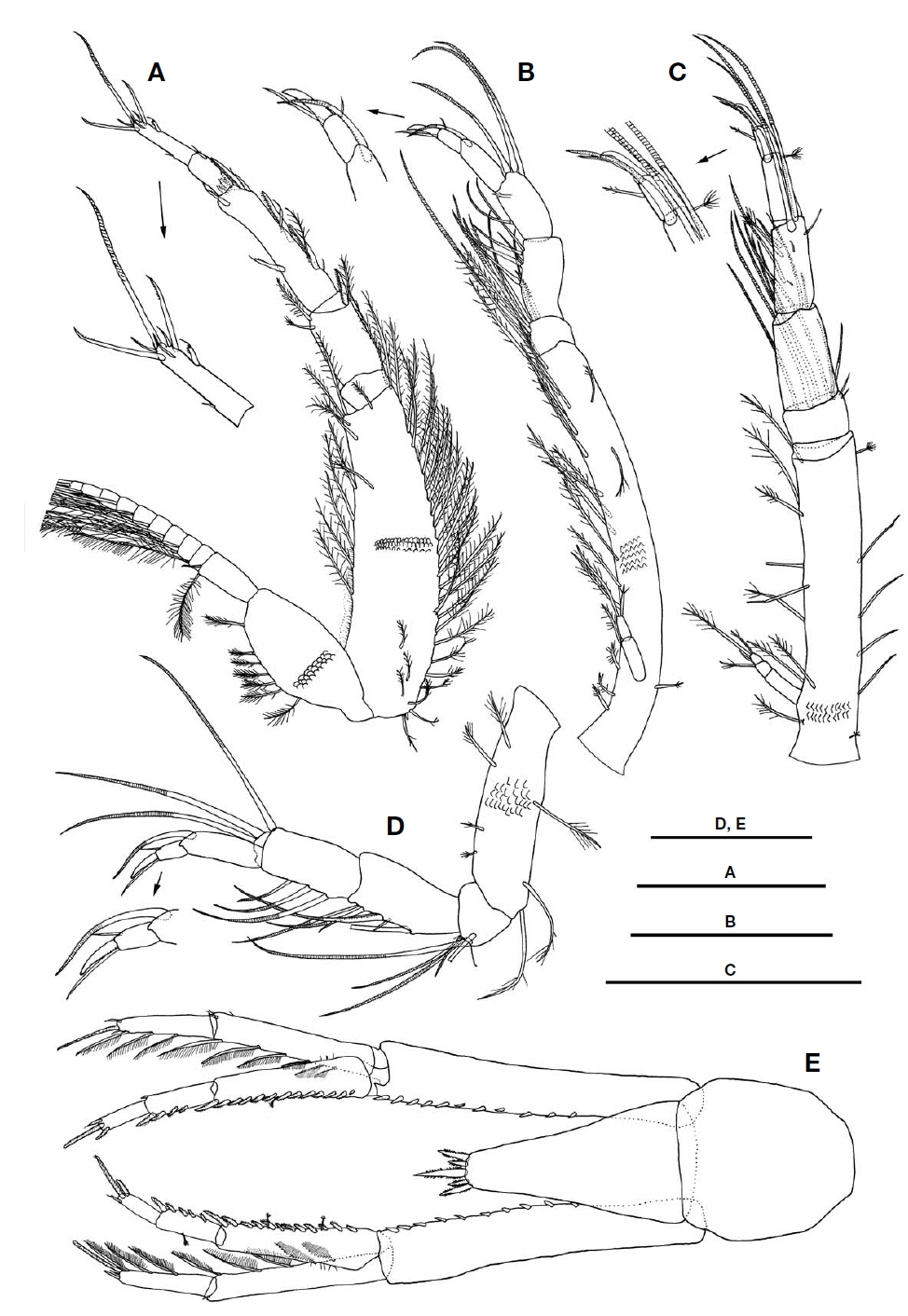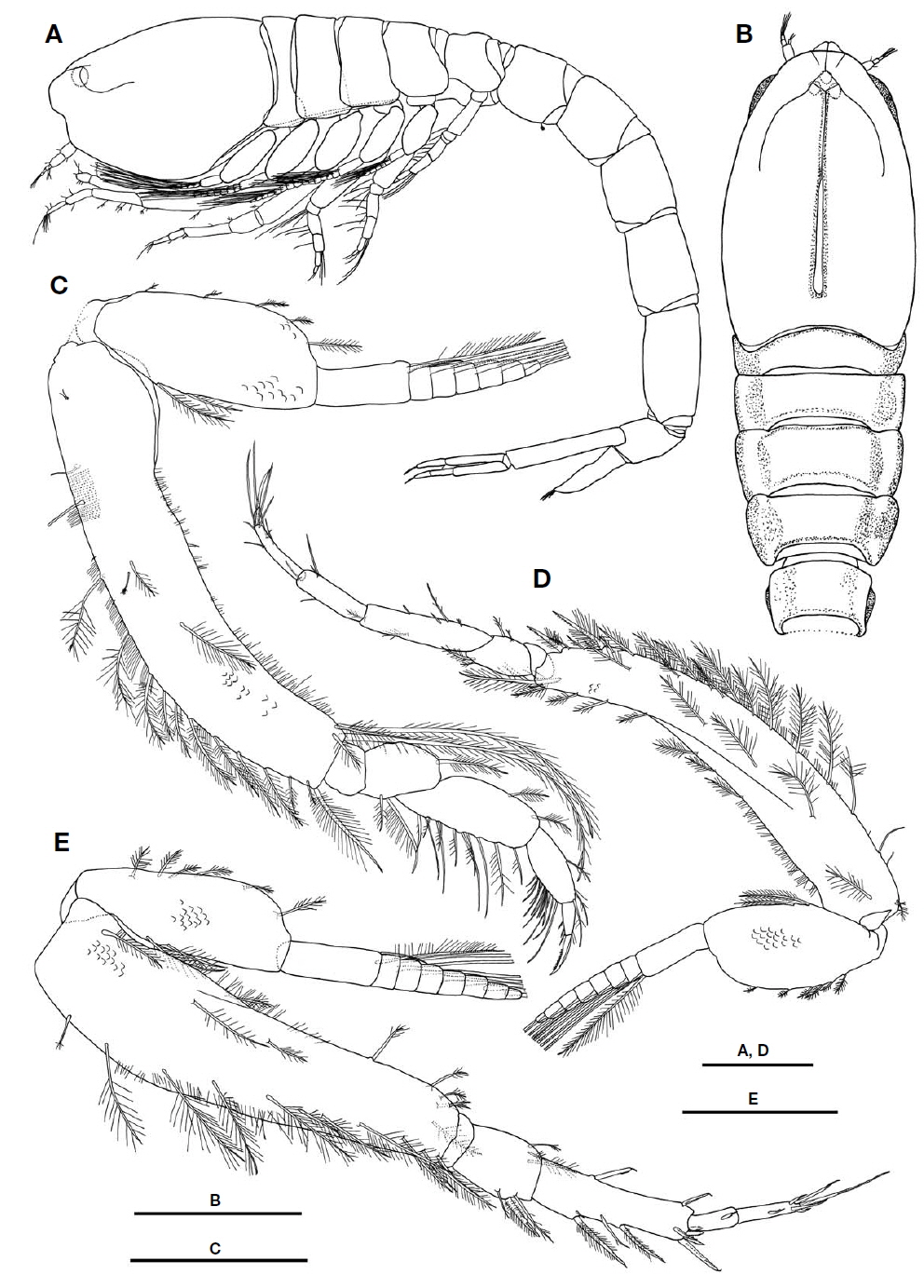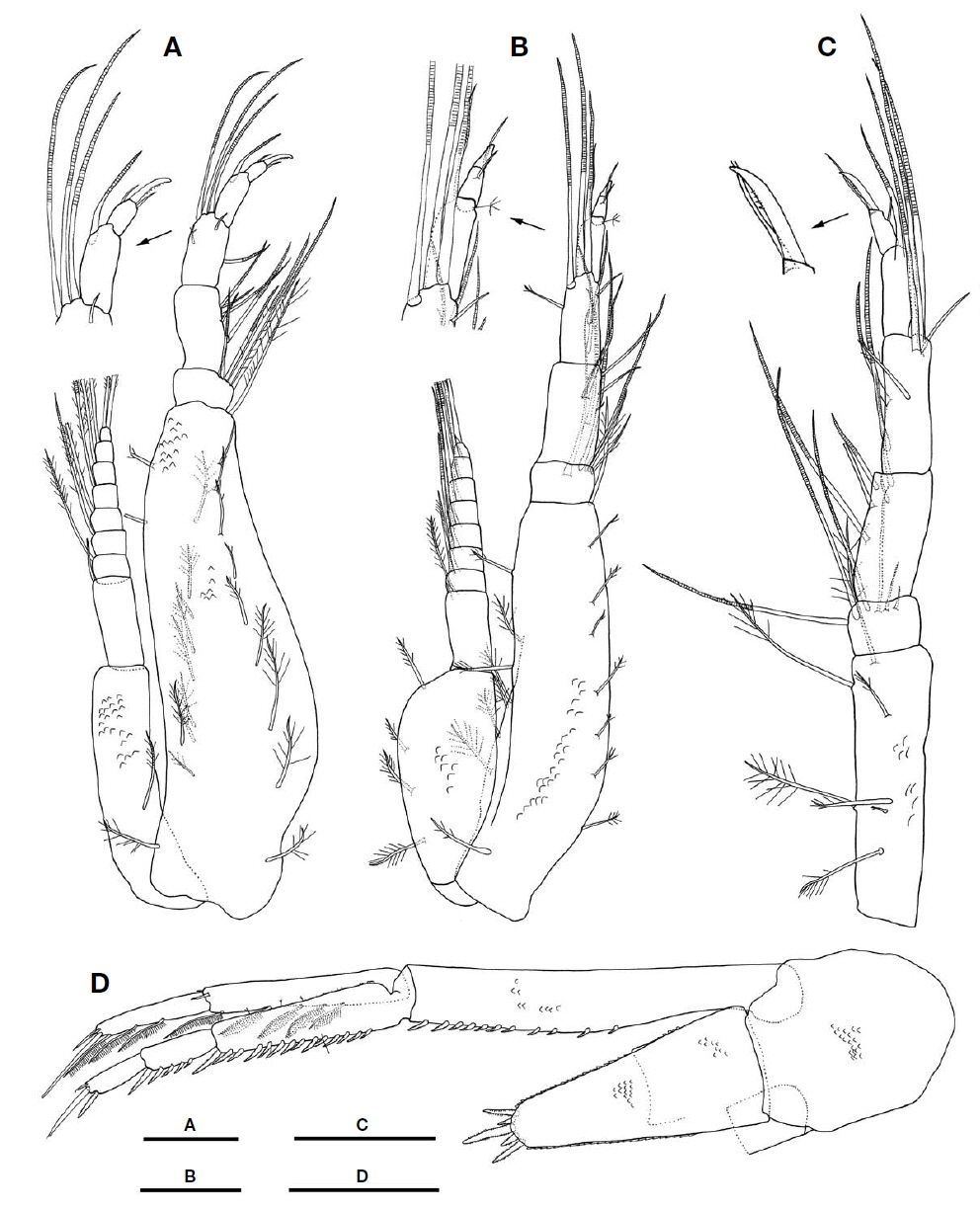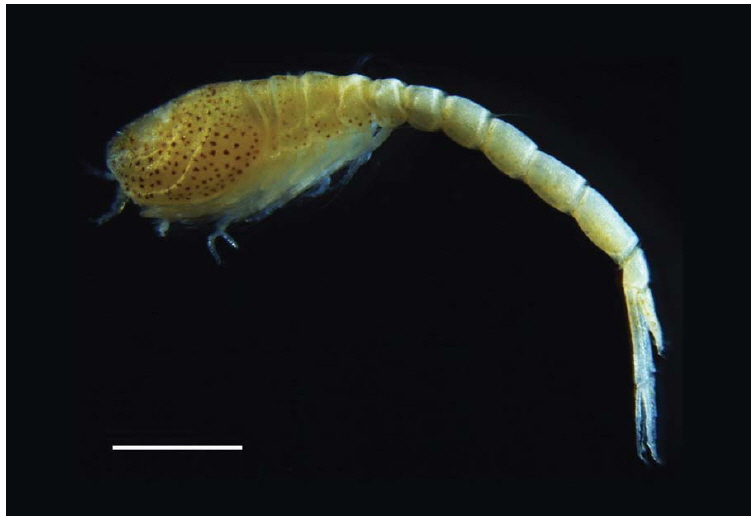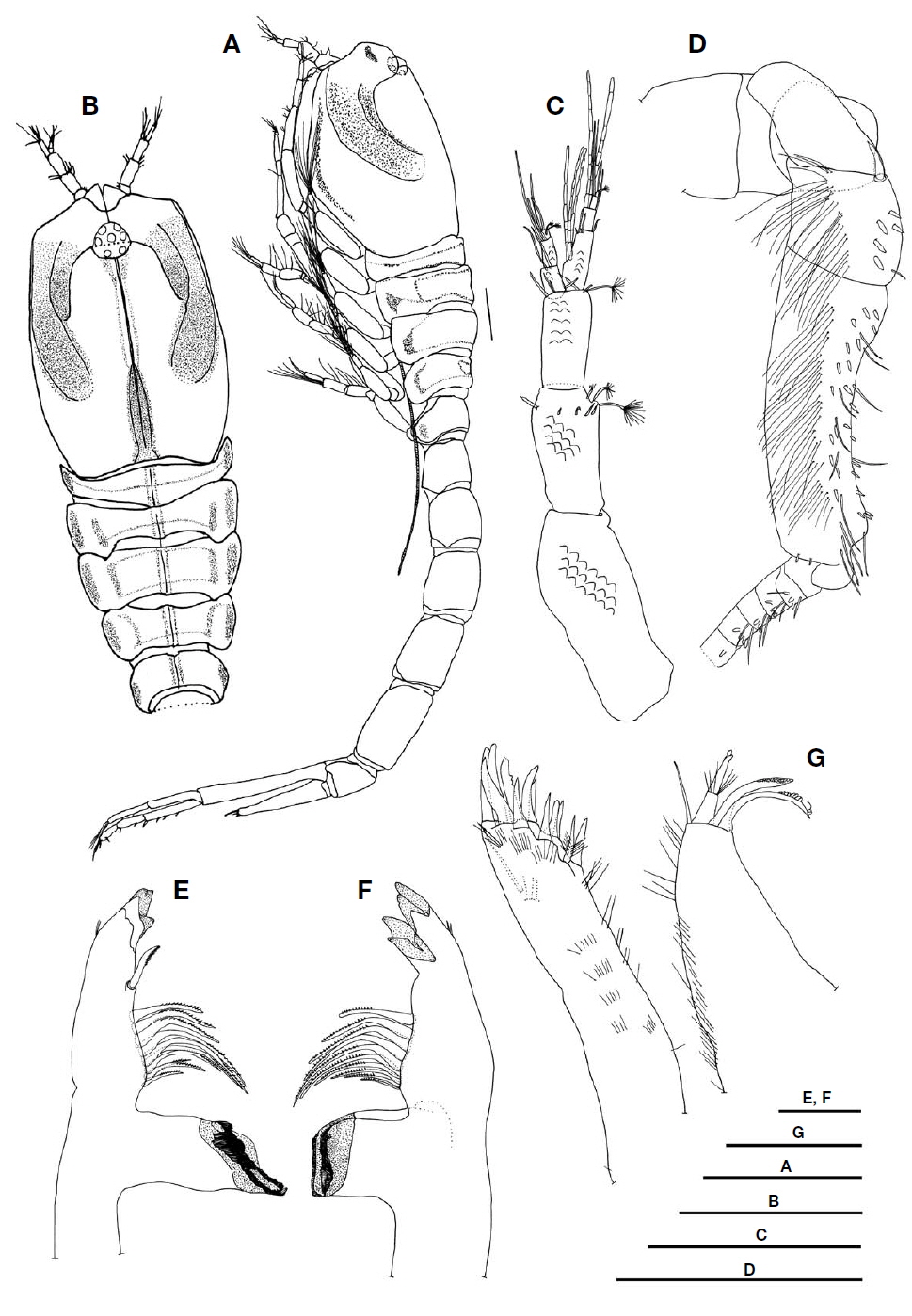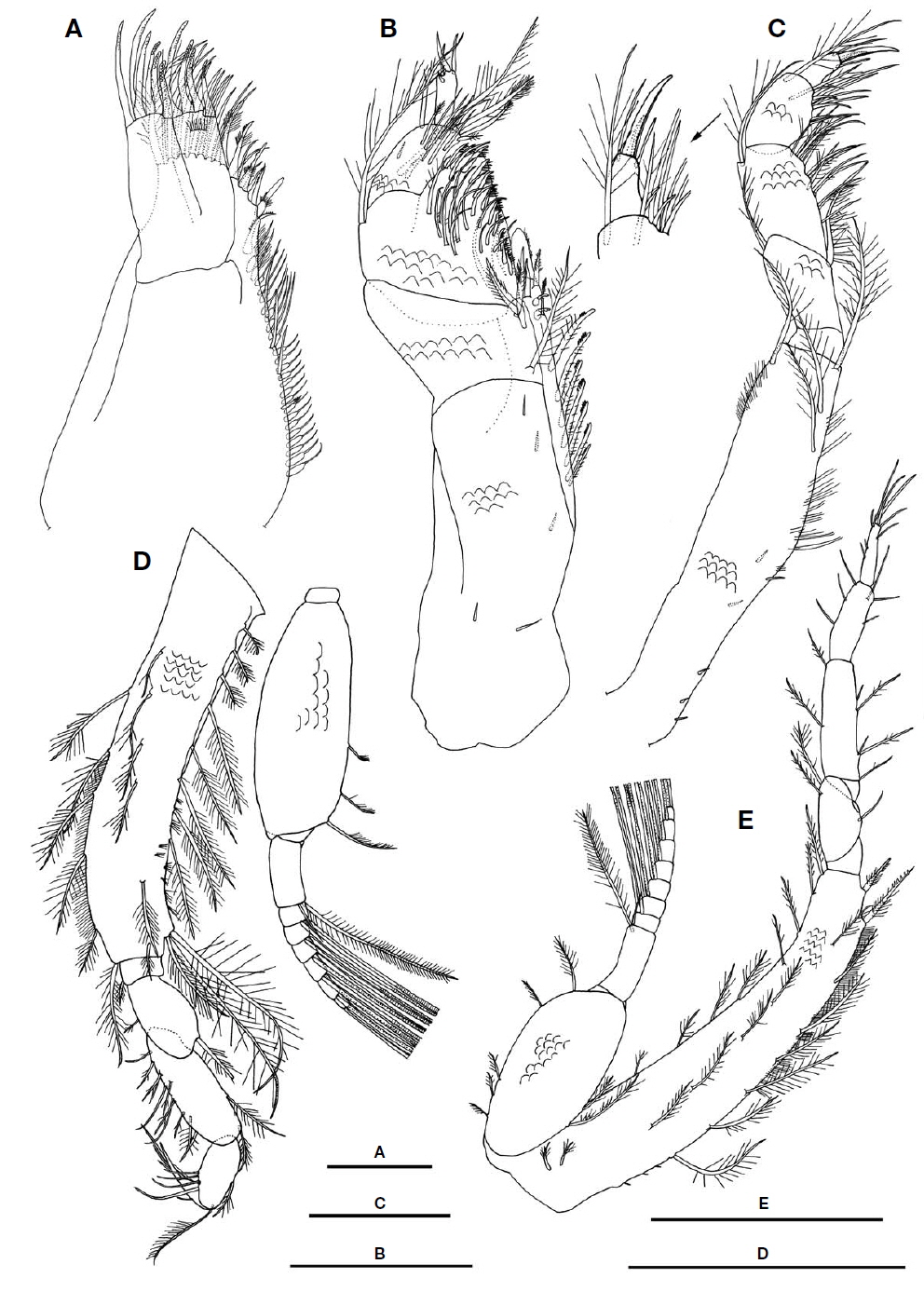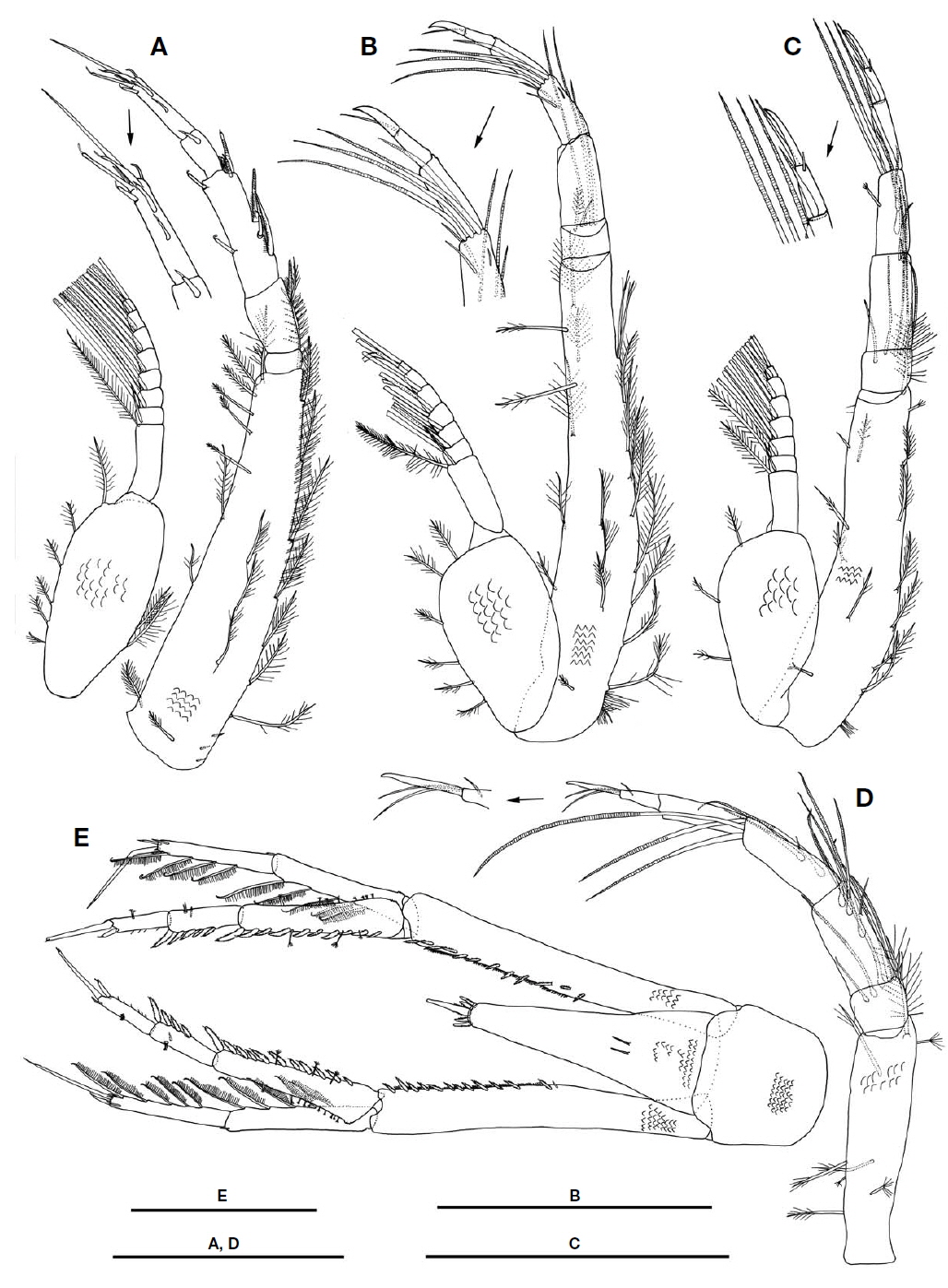



Lampropidae is a relatively small family, comprised of about 100 species in 13 genera, and is generally found in colder, deeper waters (Gerken, 2010). Among the genera,
Order Cumacea Kröyer, 1846
Family Lampropidae Sars, 1878
Material examined. 3♂♂, 10♀♀, Korea: Gangwon-do, Goseong-gun, Geojin-eup, Geojin Port, 38°26′44′′N, 128° 27′40′′E, 11 Apr 2013, Hong SS, Kim SH.
Description. Female (cat no. DKUCUM 201401): Body (Figs. 1A, 2A) about 7.0-9.2 mm long, surface is decorated with a scale-like sculpturing. Carapace (Fig. 2A, B) smooth, without oblique ridges, 0.2 times as long as body, 1.3 times as long as wide.
Thorax (Fig. 2A, B) 1.2 times as long as carapace, 0.3 times as long as body.
Antenna 1 (Fig. 2C) peduncle triarticulate; article 1 slightly shorter than remaining articles combined, with hair-like setae on ventroproximal margin, 3 complex pedunculate and 2 pedunculate setae dorsodistally; article 2 about 0.7 times as long as article 1, with 2 small simple and 4 complex pedunculate setae dorsodistally, and 1 small seta ventrodistally; article 3 about 0.9 times as long as article 2, with 3 simple and 1 complex pedunculate setae distally; main flagellum triaticulate, subequal to peduncular article 3; accessory flagellum triaticulate, subequal to flagellum article 1.
Antenna 2 vestigial.
Right mandible (Fig. 2D) boat-shaped, with row of 11 lifting setae between lacinia mobilis and pars molaris; incisor with 3 cusps.
Left mandible (Fig. 2E) similar to right, with row of 9 lifting setae; incisor with 4 cusps; lacinia mobilis with 6 cusps.
Maxilla 1 (Fig. 2F) outer endite broad with a row of 3 stout simple, 9 microserrate, and 1 pappose setae terminally and hair-like setae subterminally, lateral margin with 1 microserrate and 3 slender simple setae, medial with hair-like setae; inner endite with 1 papposerrate, 3 microserrate, and 1 simple setae terminally, lateral margin with hair-like setae.
Maxilla 2 (Fig. 2G) broad endite with 8 simple, 7 papposerrate, and 1 plumose setae terminally, near medial face with a row of 29 simple, 2 microserrate, and 1 pappose setae; outer narrow endite with 4 simple and 3 microserrate setae terminally, inner narrow endite with 3 microserrate setae terminally.
Maxilliped 1 (Fig. 3A) basis produced distally as blunt lobe, 2 hook, 5 pappose medially, 5 simple, 1 stout knoblike, and 1 pappose setae distally; ischium absent; merus with 4 pappose seta medially; carpus with many simple, 5 plumose, 11 comb setae on medial face, 1 long plumose seta laterodistally; propodus with 3 plumose, 3 pappose, and 18 simple setae medially; dactylus with 2 microserrate and 1 simple setae terminally.
Maxilliped 2 (Fig. 3B) basis subequal to remaining articles combined, with 3 plumose setae on subdistal surface, several hair-like setae on medial margin; merus 0.8 times as long as carpus, with 2 plumose setae distally; carpus with 1 plumose seta laterodistally, 14 plumose setae medially; propodus 0.7 times as long as carpus, with 3 simple setae laterally, 1 long plumose seta laterodistally, 13 simple and 1 pappose setae medially; dactylus with 2 simple, 2 microserrate, and 1 stout microserrate setae terminally.
Maxilliped 3 (Fig. 3C) basis elongate, 1.7 times as long as remaining articles combined, with a row of 19 plumose setae posteriorly, 1 pappose seta posterodistally, row of hair-like setae anteriorly, 1 pappose and 3 plumose setae anterodistally; ischium short, with 2 small plumose setae posteriorly; merus 0.8 times as long as carpus, with 4 plumose setae; carpus with 2 plumose setae anterodistally, 8 plumose and 6 simple setae posteriorly; propodus 0.5 times as long as carpus, with 3 plumose, 1 simple setae anteriorly, 9 simple setae posteriorly; dactylus with 1 stout simple and 4 slender simple setae terminally; exopod shorter than basis, flagellum with 1 simple and numerous plumo-annulate setae.
Pereopod 1 (Fig. 3D) basis curved, subequal to remaining articles combined, with 5 pappose, numerous plumose, 12 small simple, 1 simple, 2 papposerrate, and numerous hair-like setae posteriorly, 10 plumose and hair-like setae anteriorly; ischium short, unarmed; merus 0.4 times as long as carpus, with 4 plumose and 1 small simple setae; carpus with 5 plumose and 2 small simple setae; propodus 0.6 times as long as carpus, with 5 simple setae; dactylus 0.9 times as long as propodus, with 9 simple, 2 microserrate, and 2 slender simple setae; exopod shorter than basis, flagellum with 1 simple and numerous plumo-annulate setae.
Pereopod 2 (Fig. 4A) basis shorter than remaining articles combined, with numerous plumose setae posteriorly, 6 pappose setae on near postero-proximal margin, 8 plumose setae anteriorly, 1 pappose and 2 plumose setae distally; ischium with 1 plumose seta on medial posterior surface; merus 0.6 times as long as carpus, with 3 plumose and 1 papposerrate setae; carpus with 1 small simple, 1 plumose, 3 papposerrate, 3 small microserrate setae and 4 microserrate setae with single subterminal setule; propodus 0.3 times as long as carpus, with 1 microserrate seta with single subterminal setule; dactylus 1.4 times as long as propodus, with 1 small simple, 5 microserrate, 1 annulate setae and 1 microserrate setae with single subteminal setule; exopod longer than basis, flagellum with 1 simple and numerous plumo-annulate setae.
Pereopod 3 (Fig. 4B) basis elongate, 1.7 times as long as remaining articles combined, with 1 pappose and 18 plumose setae; ischium 0.4 times as long as merus, with 5 annulate and 1 plumose setae distally; merus subequal to carpus, with 4 annulate and 1 simple setae anteriorly; carpus longer than propodus, with 4 annulate, and 1 plumose setae; propodus with 1 annulate seta; dactylus 0.6 times as long as propodus, with 1 stout simple and 2 simple setae; exopod rudimentary, biarticulate, article 2 shorter than article 1, with 2 plumose setae terminally.
Pereopod 4 (Fig. 4C) basis subequal to remaining articles combined, with 7 plumose, 4 simple, and 2 complex pedunculate setae; ischium 0.4 times as long as merus, with 2 simple and 6 annulate setae distally; merus subequal to carpus, with 1 simple and 3 annulate setae distally; carpus longer than propodus, with 3 simple, 1 plumose, and 5 annulate setae; propodus longer than dactylus, with 1 complex pedunculate and 1 annulate setae; dactylus with 1 plumose, 1 stout simple and 1 simple setae; exopod rudimentary, triarticulate, article 1 longer than remaining articles 2-3 combined.
Pereopod 5 (Fig. 4D) basis 0.6 times as long as remaining articles combined, with 6 plumose and 1 complex pedunculate setae; ischium 0.2 times as long as merus, with 5 annulate setae and 2 setules anterodistally; merus subequal to carpus, with 5 annulate and 1 simple setae anteriorly; carpus longer than propodus, with 6 annulate setae; propodus longer than dactylus, with 1 annulate seta posterodistally; dactylus with 1 stout and 2 simple setae; exopod absent.
Telson (Fig. 4E) triangle form, slightly concave midlaterally, 1.9 times as wide as long, 1.3 times as long as pleonite 6, with 5 stout microserrate setae of which middle one is longest, a pair of setae between middle and lateral setae shorter than lateral ones. Uropodal peduncle (Fig. 4E) 1.4 times as long as telson, with 10-11 small stout simple setae medially; endopod triarticulate, 0.8 times as long as peduncle; article 1 longest, 2.7 times as long as article 2, with 12-13 small stout microserrate and 1-2 complex pedunculate setae medially; article 2 slightly longer than article 3, with 4-5 small stout microserrate setae medially; article 3 with 1 simple, 1 long microserrate, and 1 small stout microserrate setae terminally, 1simple and 1 long microserrate setae with single subteminal setule; exopod biarticulate, 0.8 times as long as endopod, article 1 1.7 times as long as article 2, with 5-6 plumose setae medially; article 2 with 3 plumose setae medially, 2-3 simple and 1 long microserrate setae terminally.
Male (cat no. DKUCUM 201402): Body (Figs. 1B, 5A) about 7.2-7.9 mm long, surface is decorated with a scalelike sculpturing. Carapace (Fig. 5A, B) 0.2 times as long as body length, 1.5 times as long as wide.
Thorax (Fig. 5A, B) subequal to length of carapace, 0.2 times as long as body length.
Antenna 1 similar to that of female.
Antenna 2 broken.
Mouth parts similar to these of female except exopod of maxilliped 2 is not fan form.
Maxilliped 3 (Fig. 5C) basis 1.5 times as long as remaining articles combined, with 11 plumose, 1 pappose and hair-like setae posteriorly, 1 pappose, 1 complex peduncle and 2 plumose setae on lateral surface, numerous hair-like setae anteriorly, 2 plumose and 2 long plumose setae anterodistally; ischium unarmed; merus 0.6 times as long as carpus, with 2 plumose setae posteriorly, 1 plumose seta anterodistally; carpus with 2 plumose setae anteriorly, 7 plumose and 4 simple setae posteriorly; propodus 0.6 times as long as carpus, with 3 plumose setae and 1 setule anteriorly, 13 simple setae posteriorly; dactylus with 1 shout microserrate and 3 small plumose setae posterodistally; exopod subequal to basis, flagellum with 1 simple and numerous plumo-annulate setae.
Pereopod 1 (Fig. 5D) basis 1.3 times as long as remaining articles combined, with 15 plumose, 2 simple, 2 papposerrate, and hair-like setae posteriorly, 1 pappose and 1 complex peduncle setae on postero-proximal margin, 5 plumose setae on lateral surface, 6 plumose and hair-like setae anteriorly, 3 plumose setae anterodistally; ischium unarmed; merus 0.5 times as long as carpus, with 4 plumose setae; carpus with 4 plumose and 2 small simple setae; propodus 0.6 times as long as carpus, with 4 simple setae; dactylus subequal to propodus, with 10 simple and 1 long microserrate setae; exopod shorter than basis, flagellum with 1 simple and numerous plumo-annulate setae.
Pereopod 2 (Fig. 5E) basis longer than remaining articles combined, with 1 complex pedunculate, 11 plumose, and hair-like setae posteriorly, 3 plumose setae on lateral surface, 6 plumose and hair-like setae anteriorly, 1 plumose mediodistally; ischium unarmed; merus 0.5 times as long as carpus, with 5 plumose and 1 papposerrate setae; carpus with 1 small simple, 2 papposerrate, 3 small microserrate, 1 plumose setae and 4 microserrate with single subterminal setule setae; propodus 0.3 times as long as carpus, with 1 microserrate with single subterminal setule setae; dactylus 1.3 times as long as propodus, with 6 microserrate and 1 annulate setae; exopod slightly longer than basis, flagellum with 1 simple and numerous plumo-annulate setae.
Pereopod 3 (Fig. 6A) basis longer than remaining articles combined, with 9 plumose setae on near posterior surface, 1 plumo-annulate seta posterodistally, 9 plumose setae medially, 2 plumose setae on near anterior margin; ischium 0.4 times as long as merus, with 3 annulate, 1 simple and 2 plumo-annulate setae posterodistally; merus subequal to carpus, with 5 annulate setae posteriorly; carpus with 4 annulate, 1 simple, and 1 small plumose setae; propodus 0.8 times as long as carpus, with 1 annulate seta anterodistally; dactylus 0.4 times as long as propodus, with 2 simple and 1 stout microserrate setae terminally; exopod slightly shorter than basis, flagellum with 1 simple and numerous plumo-annulate setae.
Pereopod 4 (Fig. 6B) basis longer than remaining articles combined, with 16 plumose setae; ischium 0.5 times as long as merus, with 5 annulate setae mediodistally; merus subequal to carpus, with 1 simple and 2 annulate setae posterodistally, 3 annulate setae mediodistally; carpus longer than propodus, with 1 simple seta posterodistally, 1 plumose seta anteriorly, 2 annulate setae medially, 3 annulate setae anterodistally; propodus longer than dactylus, with 1 complex pedunculate and 1 annulate setae; dactylus with 1 stout simple and 2 simple setae; exopod longer than basis, flagellum with 1 simple and numerous plumo-annulate setae.
Pereopod 5 (Fig. 6C) basis 0.6 times as long as remaining articles combined; with 6 plumose and 1 complex pedunculate setae; ischium 0.4 times as long as merus, with 1 plumose seta anteriorly, 2 annulate, 3 simple setae mediodistally; merus subequal to carpus, with 4 annulate and 1 simple setae medially; carpus longer than propodus, with 1 plumose seta on lateral surface, 2 annulate setae anteriorly, 1 simple and 3 annulate setae posterodistally; propodus longer than dactylus, with 1 annulate seta posterodistally; dactylus with 1 simple setae posteriorly, 1 stout microserrate and 1 simple setae terminally; exopod absent.
Telson (Fig. 6D) similar to that of female, except slightly more narrow, 2.2 times as wide as long and lateral margin straight. Uropodal peduncle (Fig. 6D) 1.5 times as long as telson, with 11 small stout microserrate setae on inner margin, outer margin unarmed; endopod triarticulate, 0.9 times as long as peduncle; article 1 2.8 times as long as article 2, with 14 small stout microserrate setae medially, small acute saw teeth on near lateral proximal corner; article 2 subequal to article 3, with 5 small stout microserrate setae medially; article 3 with 1 microserrate setae and 2 simple setae with single subterminal setule terminally; exopod biarticulate, article 1 1.8 times as long as article 2, with 5 plumose setae medially, 1 small simple seta and 1 simple seta with single subterminal setule on near lateral distal; article 2 with 3 plumose setae medially, 1 small simple seta and 2 simple setae with single subterminal setule terminally.
Distribution. Canada (Gabriola, Vancouver, British Columbia), Korea (East Sea), USA (Homer, Unimak Island, Alaska; Eureka, San Francisco, San Hose, California).
Remarks. The following characteristics of the specimens of
Material examined. 11♂♂, Korea: Gangwon-do: Goseong-gun, Geojin-eup, Geojin Port, 38°26′44′′N, 128°27′40′′E, 11 Apr 2013, Hong SS, Kim SH; 6♂♂, Goseong-gun, Geojin- eup, Geojin Port, 15 Feb 2014, Hong SS.
Description. Male (cat no. DKUCUM 201403): Body (Figs. 7, 8A) about 5.1-5.6 mm long, surface is decorated with a scale-like sculpturing. Carapace (Fig. 8A, B) with two pairs of oblique ridges, 0.2 times as long as body, 1.4 times as long as wide; dorsal carina well developed, reaching 0.9 times distal end of carapace, with narrow groove dorsodistally; frontal lobe close to upper oblique ridge, but not reached; two pairs of oblique ridges well marked, both not connected posterodorsally, concave between two ridges. Ocular lobe round with 7 lenses. Pereonites 1-4 carinate dorsally, with transverse mesial ridges.
Antenna 1 (Fig. 8C) peduncle triarticulate; article 1 unarmed, subequal to remaining articles combined; article 2 0.6 times as long as article 1, with 4 small simple setae subdistally and 1 simple setae with single subterminal setule, 3 complex pedunculate setae ventrodistally; article 3 subrectangular, 0.8 times as long as article 2, with 3 simple, 1 complex pedunculate, 1 pedunculate setae and 1 simple setae with single subterminal setule distally; main flagellume 4-articulate including distal minute article, slightly longer than peduncular article 3; accessory flagellume triaticulate, subequal to main flagellum article 1.
Antenna 2 (Fig. 8A, D) elongate, reaching end of plenoite 3; peduncle 5-articulate, articles 4-5 with stout and simple setae, and numerous long setules.
Right mandible (Fig. 8E) boat-shaped, with row of 11 lifting setae, incisor with 3 cusps.
Left mandible (Fig. 8F) similar to right, but bearing lacinia mobilis with 2 cusps.
Maxilla 1 (Fig. 8G) outer endite with row of 10 stout simple, 1 stout serrate, and 1 stout pappose setae terminally, 3 tufts of 7 setules subterminally, 5 tufts of setules medially; inner endite with 1 stout pappose, 1 stout scimitar shape simple, 1 stout microserrate by blunt teeth, and 1 simple setae on terminal corner, hair-like setae on lateral margin.
Maxilla 2 (Fig. 9A) broad endite with 1 plumose, 16 simple, 4 papposerrate, and 1 microserrate setae terminally, near medial face with a row of 28 simple, 1 pappose, 1 microserrate, and hair-like setae; outer narrow endite with 6 microserrate setae terminally, inner narrow endite with 4 microserrate setae terminally.
Maxilliped 1 (Fig. 9B) basis produced distally as blunt lobe, with 5 simple setae on face, 2 hook, 7 papposerrate, and 1 pappose setae medially, 1 stout knoblike, 1 simple, and 1 pappose setae distally; ischium absent; merus with 1 plumose and 3 pappose setae medially; carpus with 12 simple, 11 comb, and 5 plumose setae medially, 2 simple setae dorsally, 1 long plumose seta laterodistally; propodus with 4 plumose, 2 pappose, and 5 simple setae medially, 3 simple setae dorsally; dactylus with 4 simple setae subterminally.
Maxilliped 2 (Fig. 9C) basis longer than remaining articles combined, with 4 plumose setae subdistally; ischium short, unarmed; merus slightly shorter than carpus, with 2 plumose setae distally; capus with 11 plumose and 2 simple setae medially, 1 plumose seta laterodistally; propodus 0.9 times as long as carpus, with 2 plumose and 8 simple setae subterminally; dactylus slender, slightly longer than propodus, with 1 stout simple and 4 simple setae terminally.
Maxilliped 3 (Fig. 9D) basis longer than remaining articles combined, with 6 plumose and hair-like setae posteriorly, 6 plumose setae on lateral surface, 8 plumose and hairlike setae anteriorly, 3 plumose setae anterodistally; ischium short, with 1 small plumose seta posterodistally; merus 0.7 times as long as carpus, with 1 plumose seta posteriorly, 1 plumose seta anterodistally; carpus with 7 plumose and 4 simple setae posteriorly, 2 plumose setae anterodistally; propodus 0.5 times as long as carpus, with 4 simple setae possteriorly, 2 plumose setae anterodistally; dactylus with 1 simple seta anteriorly, 3 simple and 1 stout simple setae terminally; exopod longer than basis, flagellum with 1 simple and numerous plumoannulate setae.
Pereopod 1 (Fig. 9E) basis 1.2 times as long as remaining articles combined, with 6 plumose, 2 papposerrate, and hair-like setae posteriorly, 5 plumose and 2 pappose setae on lateral surface, 8 plumose setae anteriorly; ischium unarmed; merus 0.6 times as long as carpus, with 1 simple seta on posteriorly, 2 pappose setae anterodistally; carpus with 5 plumose and 2 small simple setae; propodus 0.6 times as long as carpus, with 6 simple setae; dactylus 0.8 times as long as propodus, with 2 simple setae anteriorly, 7 simple setae subterminally; exopod shorter than basis, flagellum 1 simple and numerous plumo-annulate setae.
Pereopod 2 (Fig. 10A) basis longer than remaining articles combined, with 3 small simple setae on near medial postero-proximal margin, 7 plumose and hair-like setae posteriorly, 1 plumose seta posterodistally, 4 plumose setae on lateral surface, 9 plumose anteriorly; ischium unarmed; merus 0.6 times as long as carpus, with 1 plumose and 1 papposerrate setae posterodistally; carpus with 2 papposerrate and 3 small stout microserrate setae, 1 microserrate and 4 simple setae with single subterminal setule; propodus 0.4 times as long as carpus, with 1 simple seta with single subterminal setule; dactylus 1.8 times as long as propodus, with 1 long simple, 2 small simple setae, and 5 simple setae with single subterminal setule; exopod longer than basis, flagellum with 1 simple and numerous plumo-annulate setae.
Pereopod 3 (Fig. 10B) basis longer than remaining articles combined, with 1 pappose seta and setules on postero-proximal margin, 10 plumose setae posteriorly, 4 plumose setae on lateral surface, 4 plumose setae anteriorly, 3 plumose setae on medial surface; ischium 0.4 times as long as merus, with 3 annulate, 1 simple and 1 plumose setae medially; merus 1.3 times as long as carpus, unarmed; carpus with 2 simple and 4 annulate setae; propodus subequal to carpus, with 1 annulate seta on lateral surface; dactylus 0.5 times as long as propodus, with 1 slender simple and 1 stout simple setae terminally; exopod shorter than basis, flagellum with 1 simple and numerous plumo-annulate setae.
Pereopod 4 (Fig. 10C) basis longer than remaining articles combined, with 11 plumose, 1 complex pedunculate, 1 simple, and 1 long pappose setae; ischium 0.4 times as long as merus, with 1 simple and 4 annulate setae mediodistally; merus subequal to carpus, with 3 annulate setae mediodistally; carpus 1.1 times as long as propodus, with 2 annulate setae medially, 1 complex pedunculate seta anteriorly, 3 long annulate setae terminally ; propodus longer than dactylus, with 1 annulate setae distally; dactylus with 2 simple and 1 stout simple setae; exopod longer than basis, flagellum with 1 simple and numerous plumo-annulate setae.
Pereopod 5 (Fig. 10D) basis 0.6 times as long as remaining articles combined; with 5 plumose and 3 complex pedunculate setae; ischium 0.5 times as long as merus, with 2 simple setae posterodistally, 4 annulate, 1 simple setae mediodistally; merus subequal to carpus, with 1 simple and 1 annulate setae posterodistally, 3 annulate setae mediodistally; carpus 1.3 times as long as propodus, with 1 small simple seta midposteriorly, 2 annulate setae medially, 3 annulate setae terminally; propodus unarmed; dactylus 0.5 times as long as propodus, with 1 simple seta posterodistally, 2 simple and 1 stout simple setae terminally; exopod absent.
Telson (Fig. 10E) isosceles triangle form, about 2.5 times as wide as long, 1.8 times as long as pleonite 6, with 2 small simple setae dorsomesially, 5 stout microserrate setae terminally of which middle one is longest, two pairs of lateral setae subequal in length. Uropodal peduncle (Fig. 10E) 1.4 times as long as telson, with 12 small stout microserrate setae and small acute saw teeth medially; endopod triarticulate, 0.8 times as long as peduncle; article 1 2.4 times as long as article 2, with 10-11 small stout microserrate and 3 complex pedunculate setae medially, each microserrate setae with single subterminal setule, small acute saw teeth on near lateral proximal corner, 7-10 complex pedunculate setae on lateral margin; article 2 1.2 times as long as article 3, with 4-5 small stout microserrate setae medially, each microserrate setae with single subterminal setule, 1 small simple, 1 pedunculate, and 1 complex pedunculate setae laterally; article 3 with 4-5 setules medially, 2 complex pedunculate setae on lateral distal margin, 1 simple setae and 2 simple setae with single subterminal setule terminally; exopod biarticulate, 0.9 times as long as endopod, article 1 1.3 times as long as article 2, with 5 plumose setae medially, small acute saw teeth on near lateral proximal corner, 1 small simple seta on lateral distal corner; article 2 with 4-5 plumose setae medially, 2 small simple setae and 3 simple setae with single subterminal setule terminally.
Distribution. Korea (East Sea), Russia (Far East, Peter the Great Bay).
Remarks. In the original description, only the female of
Key to the Korean
Carapace with distinct antennal notch; male without pleopods ∙∙∙∙∙∙∙∙∙∙∙∙∙∙∙∙∙∙∙∙∙∙∙∙∙∙∙∙∙∙∙∙∙∙∙∙∙∙∙∙∙∙∙∙∙∙∙∙∙∙∙∙∙∙∙∙∙∙∙∙∙∙∙∙
Carapace without antennal notch; male with pleopods ∙∙∙∙∙∙∙∙ ∙∙∙∙∙∙∙∙∙∙∙∙∙∙∙∙∙∙∙∙∙∙∙∙∙∙∙∙∙∙∙∙∙∙∙∙∙∙∙∙∙∙∙∙∙∙∙∙∙∙∙∙∙∙∙∙∙∙∙∙∙∙∙∙∙
Key to the Korean
Carapace with two oblique ridges laterally; in male, telson with one long mesial and two pairs of subequal lateral terminal setae ∙∙∙∙∙∙∙∙∙∙∙∙∙∙∙∙∙∙∙∙∙∙∙∙∙∙∙∙∙∙∙∙
Carapace without oblique ridge laterally; in male, telson with one long mesial and two pairs of unequal lateral terminal setae ∙∙∙∙∙∙∙∙∙∙∙∙∙∙∙∙∙∙∙∙∙∙∙∙∙∙∙∙∙∙∙∙∙∙∙∙∙∙∙∙∙∙∙∙∙∙∙∙∙
